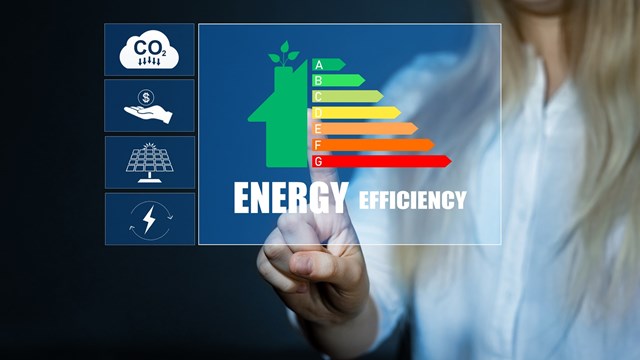In the beginning … there was light. And all this time later, we are finally harnessing light’s energy to power our cities, our buildings, and our everyday devices—mostly because all of the energy sources we’ve used until now emit incalculable amounts of carbon and other dangerous particles into the atmosphere, causing what is now widely understood to be a global climate catastrophe.
While the light was good, it was also expensive. Capturing energy from the sun requires acres and acres of enormous photovoltaic panels. Storage and distribution of that energy requires yet another set of costly infrastructure. And scaling and applying this technology to an off-the-grid cabin in the woods is much different from getting it to power an 80-story high-rise in a large city.
But over the last few decades—and particularly over the last few years, as we’ve reached our climate reckoning in the wake of disasters of near-biblical proportions—the technology and components for making and providing non-fossil-burning power are becoming cheaper, smarter, and more widely available.
The Solar Scale
Experts in the field of clean energy contend that the last 20 years have seen a huge reduction in the cost of manufacturing and installing photovoltaic modules. One of these experts is Frank van Mierlo, CEO of 1366 Technologies Inc., a company based in Bedford, Massachusetts, that is at the forefront of solar technology development and production. In a recent podcast called “The Science of Solar,” Mierlo states that the first solar technology was developed in 1954 by Bell Labs. At that time, a solar panel’s cost per kilowatt-hour was about $10. Today, he says, it’s about 4¢ to 5¢.
According to Mierlo, the material of a solar panel acts as a semiconductor, which processes electricity in a way that wastes a certain percentage of energy. The best a solar panel can do, he says, is to harness 24% of available energy from the sun, and today’s panels are approaching that limit. But new technologies promise a higher energy harvest. His company is developing a tandem module, which has the ability to increase the energy output of a solar panel by 35%. Using two semiconductors, tandem panels can capture energy from both low- and high-wavelength photons. When they become commercially available in the near future, it is expected that tandems will reduce the kilowatt-hour cost of a solar panel to 2¢.
An additional technological advancement is the actual material being used to make solar panels. The traditional polysilicon is already fairly thin and versatile, but a new material called perovskite is on its way to commercial use. Thinner and more transparent than crystalline silicon, perovskite has the potential to be layered on top of existing solar panels to boost efficiency, or be integrated with glass to make building windows that also generate power. Mierlo’s 1366 Technologies has announced a merger with Hunt Perovskite Technologies LLC, according to Bloomberg, which will combine the two technologies to create an even more efficient solar panel.
There is an uptake component that can potentially reduce costs even further—and that, says Mierlo, is the biggest challenge. It’s a major transition, in both physical components of a building or community and mental adjustments to a new way of accessing utilities. In the bigger picture, there has to be a political will to shift resources and infrastructure away from the entrenched fossil fuel industry and into a cleaner, greener energy economy. “But the solutions are there,” according to Mierlo. “We just have to decide that we want to do it.”
Another new technology taking hold in Europe and the Middle East is smart glass, also known as electrochromic glass or dynamic glass. Using a tiny burst of electricity to charge ions on a window layer, smart glass can change the amount of light it reflects. This goes beyond the low-emittance windows that block some of the sun’s radiation—an existing technology already in use in some multifamily buildings in the U.S. Rather, smart glass allows users to choose how much light they want to block. And, as the name suggests, smart window controls can be linked to a building’s management system, allowing for remote and automatic tint adjustment depending on time of day, year, weather, etc. This convenience and aesthetic enhancement can save a building or community in both HVAC costs and carbon emissions, as the U.S. Department of Energy estimates that energy lost through conventional windows accounts for approximately 30% of heating and cooling energy.
Decisions, Decisions
With all of these options, how does a board decide which one or ones to implement in their building or association and when? This is definitely an area where one size does not fit all, say the experts. Marc Zuluaga, PE, CEO of Steven Winter Associates—an architecture and engineering firm specializing in energy optimization for commercial and residential buildings with offices in New York, Connecticut, and Massachusetts—tells CooperatorNews that existing multifamily buildings would do best to “start with what you have.”
“There’s lots of sophisticated systems out there,” continues Zuluaga, “but at a minimum, looking at your annual bills and understanding the implications is as important as making sure that the data is right.” Several U.S. cities, including New York City and Chicago, have adopted benchmarking standards for large residential buildings as part of a larger climate compliance initiative. New York’s Local Law 97, for example, requires buildings over 25,000 square feet to submit professional energy assessments and achieve energy reduction benchmarks at five-year intervals leading up to 2050, when the city intends to reach its carbon-neutral goal. “Then as new equipment goes into your building,” continues Zualaga, “make that ‘smart’ equipment—that means it’s responsive to the needs of the residents and the people in the building, and includes telling you how the building’s doing, how the equipment’s doing—and you can get more sophisticated over time.”
While the first year for accurate data submission in Local Law 97 isn’t until 2024, there is no reason not to start the process now—regardless of where you live. For one thing, these types of projects take a while to research, analyze, estimate, and install. Even if you start examining your building’s energy data today, it could take until 2024 to actually implement the modifications that will bring your building to required carbon emission limits, which only get more stringent over time. And another important factor that Zuluaga indicates is that once these modifications are online, they will deliver savings in costs, usage, and efficiency, no matter where your building is located. Why not reap those benefits as soon as possible?
Kelly Doherty, vice president of FirstService Energy, the energy management and advisory subsidiary of national property management company FirstService Residential, points out that buildings and communities looking to reduce their carbon output should focus first on their heating and domestic hot water systems—because that’s where carbon mainly comes from. “So at the end of the useful life of your boiler,” she gives as an example, “you’re getting ready to replace it—what are your options for the rooftop unit that runs on gas?” Doherty echoes other experts in that it is not a one-size-fits-all approach. “Every building is going to have to create their own master plan of how they’re going to get to that threshold,” she continues.
This is an important point. Boards and their professional managers need to be strategic as they map out their goals and processes for reaching them. Thinking about any upcoming projects or capital needs with one eye on carbon reduction solutions will allow boards and managers to integrate efficiency and savings as they move forward. A holistic approach is also key. Boards should think about interdependencies of systems and components, and how projects might be completed simultaneously or in sequence to achieve the best bang for the buck in terms of both overall costs and long-term savings.
If You Build It ...
So the technology exists and it’s cost-effective … but what can a multifamily building or HOA community do if it doesn’t allow such installations? According to Solar United Neighbors, a non-profit based in Washington, D.C. that serves 12 states in addition to the District, New Jersey was one of the first states to pass a law (P.L. 2007, c. 153) that protects homeowners’ right to go solar from HOA interference. While the law “would likely not apply to individuals living in a condominium or co-op arrangement, where the roof is a common element and not ‘owned’ by individual unit owners,” says the organization, owners of stand-alone units in New Jersey HOAs have the statutory right to install solar technology on their property.
There are caveats, however. While a community association cannot completely deny a request to install a solar system, they can enforce “reasonable restrictions.” Solar United Neighbors indicates that these restrictions include “qualifications, certification, and insurance requirements of installers; location where solar collectors may be placed on roofs; concealment of solar collectors’ supportive structures, fixtures, and piping; color harmonization of solar collectors with the colors of structures or landscaping in the development; and aggregate size or coverage or total number of solar collectors.” Taken together or separately, none of these restrictions can increase the installation cost by more than 10%, and no rule can inhibit a system from operating at its maximum capacity.
Solar United Neighbors indicates that any New Jersey homeowner considering a solar system should first review the governing documents of their association to understand the exact ownership rights that apply. Contacting the association’s management company and board of directors is the appropriate next step. There may be review and approval requirements associated with the project. In the event that the homeowner feels they have been denied in violation of the law, they can contact the Association Regulation Unit in the New Jersey Department of Community Affairs for guidance: www.nj.gov/dca/divisions/codes/offices/ari.html.
Pumping It Up
Doherty notes that older buildings that still run on oil are really going to have to address moving to a new system. If they don’t have access to gas, a transition to electric heating and cooling might be the way to go. While likely a huge undertaking, the move to electric systems in general is where we are headed, and Doherty is “a big fan of heat pumps”—the technology that distributes heating and cooling from a non-fossil-burning ground or air source. An added benefit of such a system is that buildings that lacked central cooling will now be able to provide it. Additionally, it will make it easier to charge back individual unit owners or tenants for their usage—which could be a motivator for usage reduction, which in turn reduces carbon emissions, as well as costs.
It’s not necessarily an easy transition however. Says Doherty: “Some buildings are going to have issues with power, and have to bring power to the building and then to the apartments. There’s going to be issues with buildings as to where to put the condensers and where to put the units themselves. And other buildings are gonna just have issues with the costs associated with doing that conversion. There are some new technologies that are coming, and there are some demonstration projects that are happening in New York City right now through NYSERDA”—the New York State Energy Research and Development Authority—“and other agencies that are looking at converting multifamily buildings to heat pumps. So I am hopeful that we’ll have more data on how well those buildings are doing.”
The Time Is Nigh
No matter where you are, what type of building you are in, or which sustainability projects are on the list, “don’t wait ‘til the last minute,” warns Doherty. “That is when you’re going to run into problems—and you also might have problems getting incentives, because there’s going to be a ton starting in 2020 and through 2025 that you want to capture. But you need to have a plan first.”
Follow the Scout motto and be prepared. You will be saving headaches, money, and—oh, yeah—the planet.
Darcey Gerstein is Associate Editor and Staff Writer for CooperatorNews.







Leave a Comment